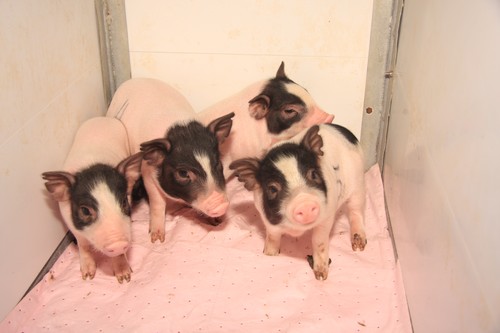Research team led by Professor Qi Zhou at the Institute of Zoology, Chinese Academy of Sciences, generated for the first time the vWF knockout pigs using CRISPR/Cas9 technology, and established the miniature pig model for von Willebrand disease (vWD). Relevant results have been published online January 31 in Cell Research, in an article entitled “One-step generation of knockout pigs by zygote injection of CRISPR/Cas system”.
Pig is the most important livestock species in China, and is a key animal model in biomedical research. Pigs are closer than rodents to human in several physiological characteristics such as cardiovascular system and gastrointestinal tract, and the size and function of their organs are very similar to that of human. They also have high litter size and are easy to breed. Based on those features, it is of significant values to manipulate the pig genomes for agriculture or biomedicine, such as generation pig disease models.
CRISPR/Cas9 system is easy to construct and can rapidly induce multiple genetic mutations. The technology has been used successfully in rats and mice but has not been applied to the research of commercial animals such as pigs. By directly injecting vWF-cleaving CRISPR/Cas system into the zygotes of miniature pigs, the research team has efficiently generated living biallelic knockout pigs, demonstrating the applicability of CRISPR technology in large animals. Compared with the conventional “two-step method” which performs gene knockout in somatic cells first and then generates gene-knockout pigs through somatic cell nuclear transfer, the “one-step method” by direct zygote injection, based on the high efficiency and convenience of CRISPR technology, is capable of generating gene-knockout pigs more rapidly and conveniently. vWF mutation will lead to type I and type III vWD in human. The study further discovered that the knockout pigs showed similar clinical phenotypes to that of vWD patients, i.e. severe coagulation disorder. This has also been the first report of generation of a mammalian disease model with specific phenotypes via CRISPR technology. The study provides a new approach to establish rapidly a genetic modified animal model utilizing pig as the object, and will promote the studies on pathogenesis and treatment of livestock epidemic diseases and human diseases.
The study was supported by the“Strategic Priority Research Program” of the Chinese Academy of Sciences, the National Program on Key Basic Research Project of China, and National Basic Research Program of China.

The Pig is the most important livestock specie in China, and serves as a key animal model for biomedical research.

